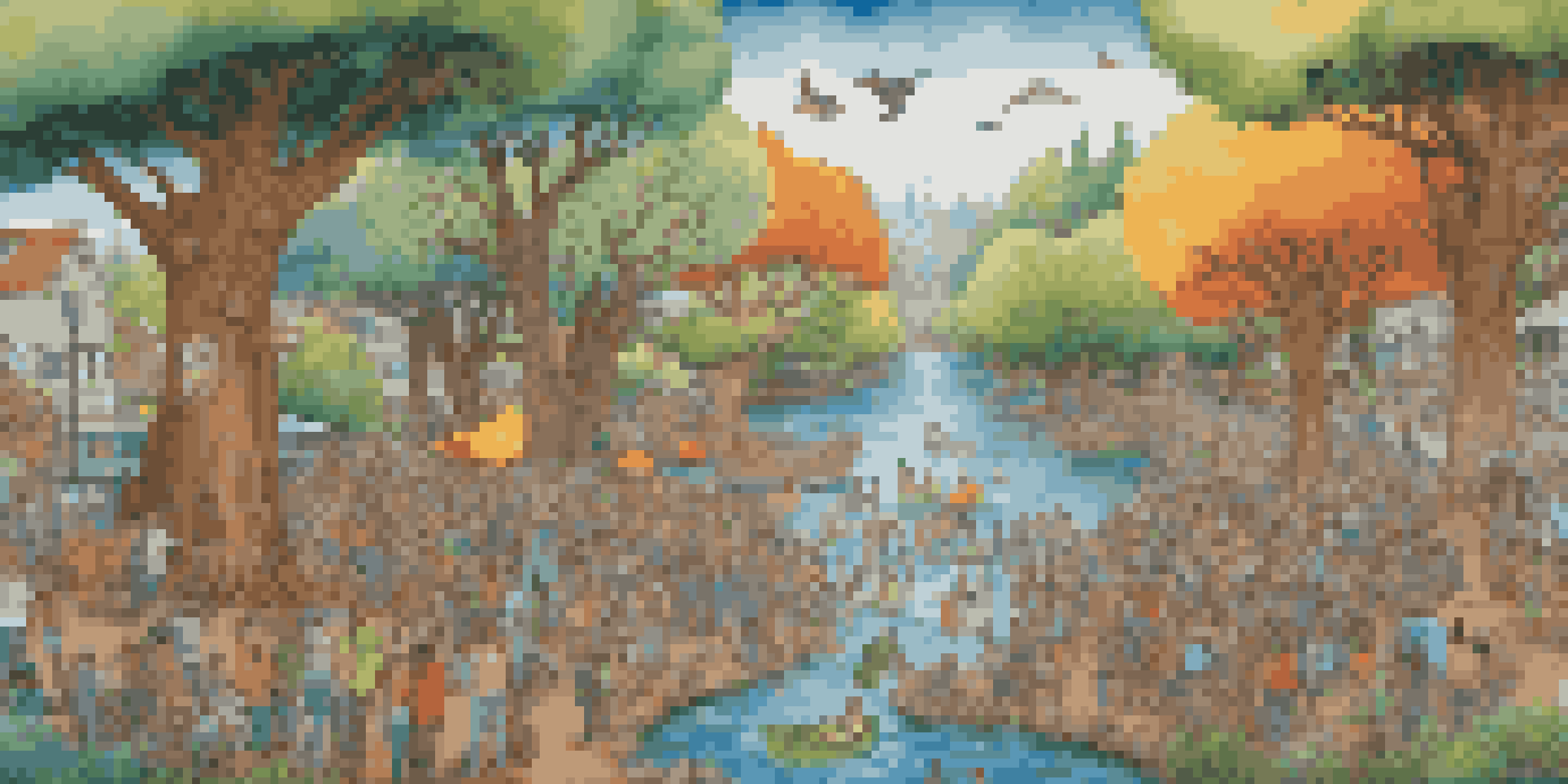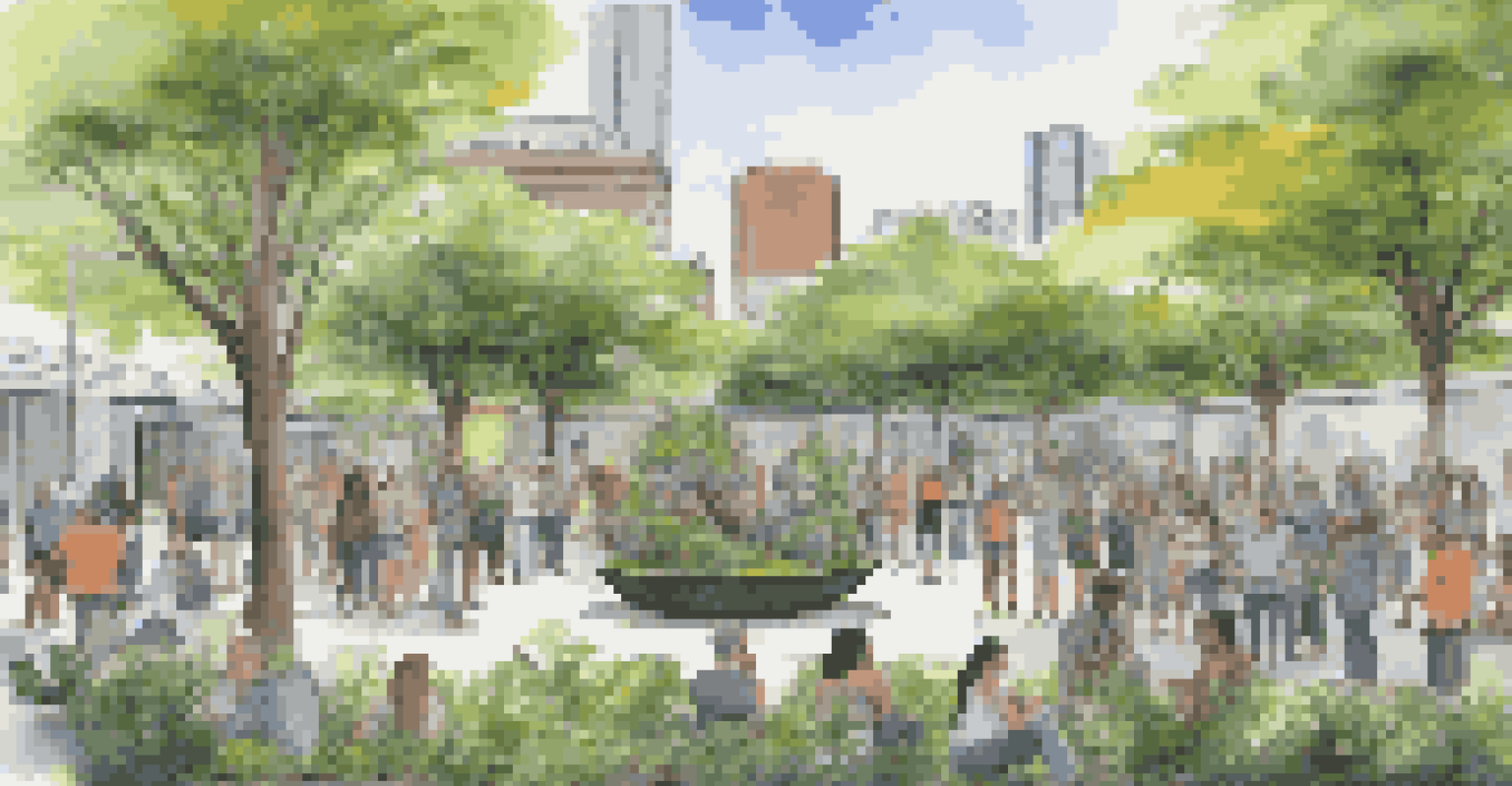Participatory Art Projects Engaging Communities in Climate Action

Understanding Participatory Art and Its Purpose
Participatory art is an innovative approach that invites community members to engage in the creative process. Rather than being mere spectators, individuals contribute their ideas, skills, and experiences, fostering a sense of ownership and connection. This engagement can be particularly powerful when addressing pressing issues like climate change, as it transforms passive observers into active participants in their environment.
Art is not a mirror to reflect the world, but a hammer with which to shape it.
Art has the unique ability to transcend barriers, making complex topics like climate action more relatable and accessible. By incorporating community voices, participatory art projects can effectively highlight local environmental challenges and inspire collective action. This method not only enhances awareness but also strengthens community bonds through shared experiences and collaborative creativity.
Ultimately, participatory art serves as a catalyst for dialogue and reflection, encouraging individuals to think critically about their role in climate action. By engaging diverse perspectives, these projects can cultivate a more profound understanding of environmental issues and empower communities to enact meaningful change together.
Case Studies: Successful Community Art Projects
One remarkable example of participatory art in climate action is the 'Tidal Shift' project in San Francisco. This initiative invited local residents to create artworks that visualize the impact of rising sea levels on their community. Through workshops and collaborative installations, participants shared their personal stories and concerns, making the abstract concept of climate change more tangible and urgent.

Another inspiring project is 'The People's Climate March,' which harnesses the power of art to mobilize communities worldwide. Artists and activists joined forces to create large-scale banners, puppets, and performances that convey a strong message about climate justice. This blend of art and activism not only raises awareness but also fosters a sense of solidarity among diverse groups.
Participatory Art Engages Communities
Participatory art invites community members to actively contribute to the creative process, fostering ownership and connection.
These case studies showcase how participatory art can effectively engage communities in discussions about climate action. By facilitating creative expression, such projects encourage individuals to reflect on their experiences and envision a more sustainable future together.
The Role of Collaboration in Participatory Art
Collaboration is at the heart of participatory art projects, allowing community members to share their unique insights and skills. This teamwork fosters a sense of belonging and encourages participants to invest emotionally in the outcomes of their projects. When individuals from different backgrounds come together, they bring varied perspectives that enrich the creative process.
The future depends on what we do in the present.
By working collaboratively, communities can address local climate issues with tailored solutions that resonate with their specific needs. For instance, a community might develop a mural that highlights the importance of preserving a nearby wetland. This artistic endeavor not only beautifies the neighborhood but also raises awareness about environmental conservation and the importance of protecting local ecosystems.
Moreover, collaboration often leads to stronger social networks, which can be vital when mobilizing for climate action. As participants build relationships through shared artistic endeavors, they create a support system that encourages ongoing engagement and collective advocacy for environmental issues.
Using Art to Foster Environmental Awareness
Art can be a powerful tool for raising awareness about climate change and its effects on communities. By transforming scientific data into visual narratives, artists can make complex information more digestible and relatable for the average person. This connection can ignite curiosity and drive individuals to learn more about the environmental challenges facing their communities.
Participatory art projects often incorporate educational components, such as workshops or discussions, that deepen participants' understanding of climate issues. For example, a community garden project might include sessions on sustainable gardening practices, enabling participants to directly apply their newfound knowledge. This hands-on experience reinforces the message and encourages eco-friendly behavior.
Collaboration Enhances Climate Action
Collaborative projects allow diverse perspectives to address local climate issues, leading to tailored solutions and stronger community bonds.
Through creative expression, art can evoke emotional responses, making the urgency of climate action more compelling. When community members see their stories reflected in artistic works, they are more likely to feel motivated to take action, whether through personal lifestyle changes or collective initiatives.
Engaging Diverse Communities in Climate Action
Participatory art projects have the potential to engage diverse communities, including underrepresented voices often excluded from environmental discussions. By providing a platform for these voices, artists can ensure that a variety of perspectives are heard and considered in climate action initiatives. This inclusivity strengthens the overall impact of the projects and fosters a sense of unity.
For instance, projects that focus on indigenous communities often center traditional ecological knowledge, highlighting sustainable practices that have been passed down through generations. By integrating this wisdom into contemporary art forms, these initiatives not only celebrate cultural heritage but also encourage broader conversations about sustainable living.
Furthermore, engaging diverse communities can lead to innovative solutions that address local climate challenges. When individuals from varied backgrounds collaborate, they can brainstorm creative approaches that reflect their unique experiences and needs, ultimately leading to more effective climate action strategies.
Challenges in Implementing Participatory Art Projects
While participatory art projects can be incredibly impactful, they also come with their own set of challenges. Securing funding and resources can be a significant hurdle, as many artists rely on grants or community support to bring their visions to life. Without adequate financial backing, projects may struggle to reach their full potential or even get off the ground.
Additionally, ensuring genuine community engagement can be tricky. It's essential for artists to build trust and rapport with participants, which can take time and effort. If community members feel like their contributions are not valued or that the project is merely a top-down initiative, it can lead to disengagement.
Art Makes Climate Issues Relatable
By transforming complex data into visual narratives, art helps communities understand and engage with climate challenges.
Finally, measuring the impact of participatory art projects can be difficult. The outcomes are often qualitative, making it challenging to quantify success in a way that appeals to stakeholders. Artists must find creative ways to communicate the value of their work and the positive changes occurring within the community as a result.
The Future of Participatory Art in Climate Action
As climate change continues to be a pressing global issue, the role of participatory art is likely to grow even more vital. Artists and communities are increasingly recognizing the potential of creative expression to inspire action and promote environmental stewardship. This trend suggests a promising future where art becomes an integral part of climate initiatives.
Emerging technologies, such as virtual reality and digital art, also present exciting opportunities for participatory projects. These tools can help bridge geographical gaps, allowing communities from different regions to collaborate and share their experiences with climate change. This interconnectedness may foster a greater sense of global solidarity as individuals come together to address a shared challenge.

Ultimately, the future of participatory art in climate action will depend on continued collaboration, innovation, and community engagement. By harnessing the power of creativity, communities can unite to confront climate challenges and work towards a sustainable future for all.